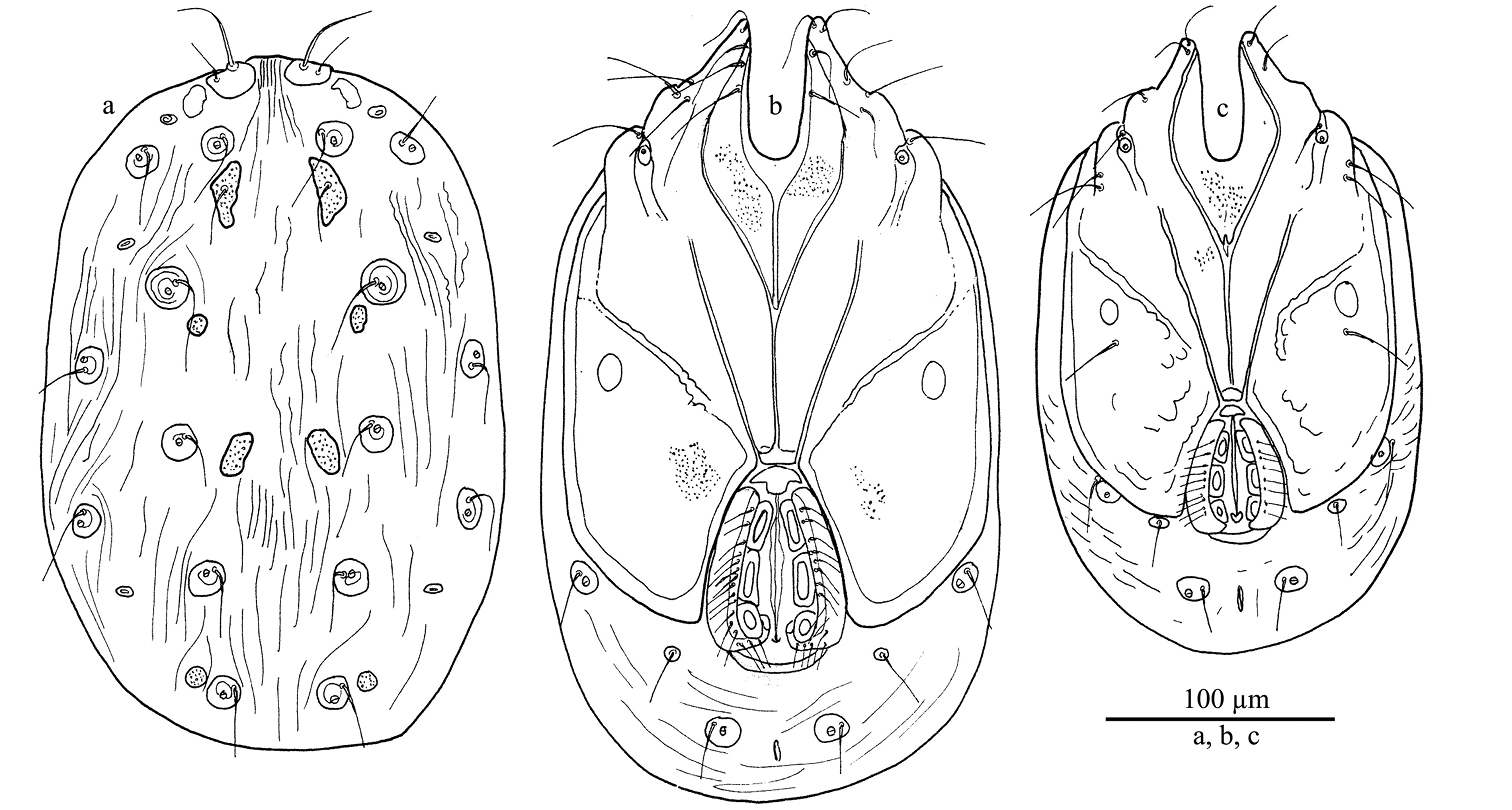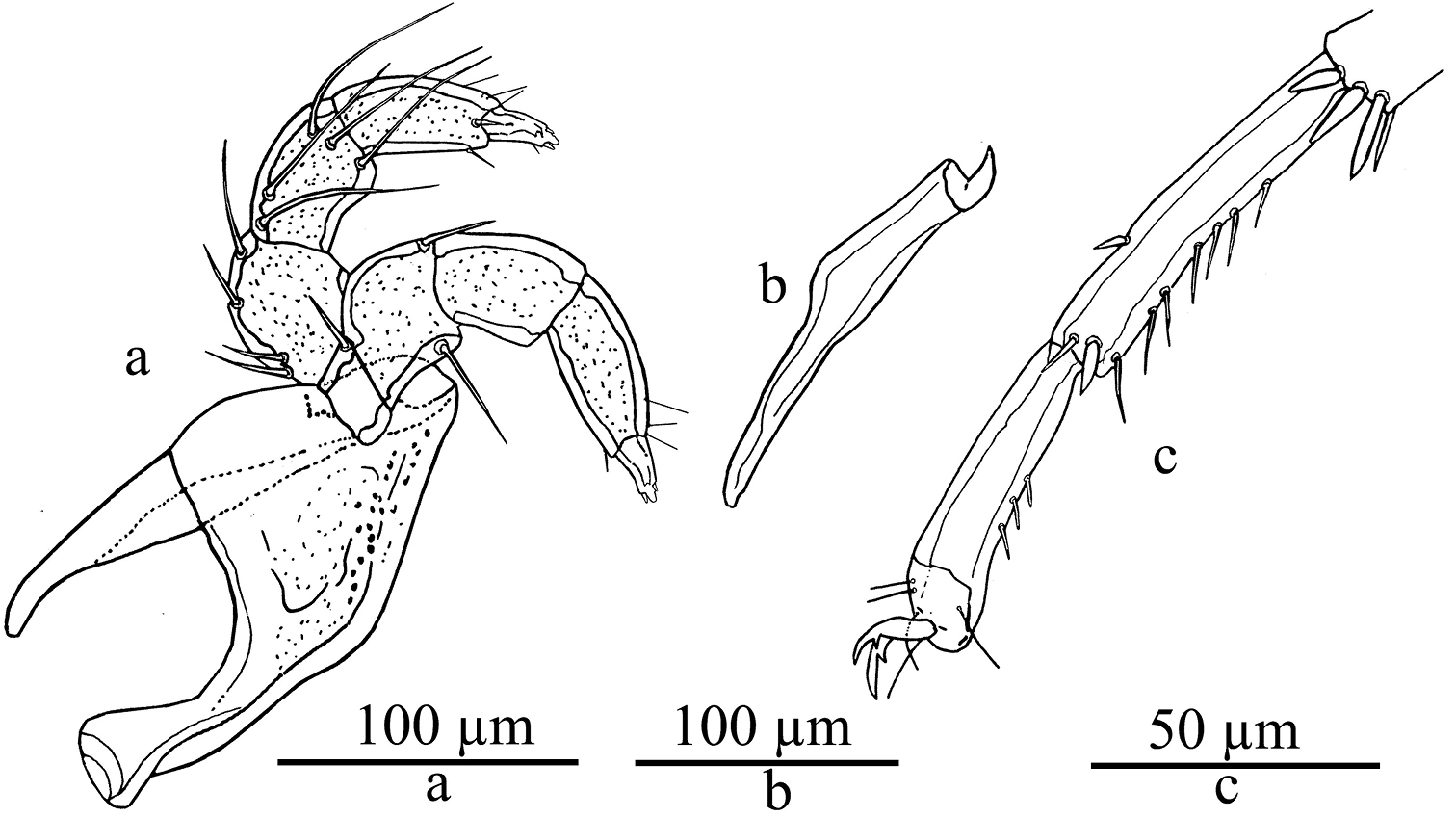






(C) 2012 Pınar Gülle. This is an open access article distributed under the terms of the Creative Commons Attribution License 3.0 (CC-BY), which permits unrestricted use, distribution, and reproduction in any medium, provided the original author and source are credited.
For reference, use of the paginated PDF or printed version of this article is recommended.
A list of species of the water mitegenus Lebertia Neuman, 1880 known from Turkey is provided, based on bibliographical data and results from recent field work, mainly in the Southwestern part of the country. We describe one new species, Lebertia martini sp. n. and report new 28 locality records from 6 provinces for the three previously known species.
Acari, water mites, new species, Lebertia, Turkey
Water mites of the family Lebertiidae reach their maximum diversity in the Holarctic region, but isolated species have been recorded in several parts of South Asia, Africa and South America (
Compared with intrageneric variation in other water mite genera, most Lebertia species are highly uniform in the shape of coxae, legs and mouth parts. Characters useful for discrimination of species and subgenera are mainly integument structures, as well as details in setation and shape of legs and palps (
The genus Lebertia is divided into 5 subgenera: Eolebertia, Mixolebertia, Pilolebertia, Brentalebertia and Lebertia s. str. (
Water mites were collected by hand netting and sorted on the spot from the living material, preserved in Koenike’s fluid (50% glycerin, 20% acetic acid, 30% aqua dest.) and dissected for slide mounting in Hoyer’s fluid. The composition of the material is given as males/females. All measurements are given in μm. The following abbreviations are used: Cx-I = first coxae, Cx-I mL = first coxae medial length, Dc-1-4 = dorsocentralia 1-4, H = height, L = length, n = number of specimens examined, P-1 = palp segment 1, W = width, IV-L-5 = fourth leg, fifth segment.
Results Family Lebertiidae Thor, 1900 Genus Lebertia Neuman, 1880 Subgenus Lebertia Neuman, 1880Antalya Province:21.07.2009, 37°03.03'N, 31°36.09'E, 4/4, 665m a.s.l., spring with Fontinalis mosses and water cress, İbradı; 09.04.2010, 36°54.84'N, 31°09.82'E, 0/2, 110m a.s.l., dense filamentous green algae, Aksu stream, Serik, collected by P. Gülle.
Muş Province (
Central, eastern and northern Europe (
Burdur Province: 24.05.2008, 37°24.43'N, 29°48.72'E, 4/5, 1050m a.s.l., small stream feeding pond, İncekiniş, Karamanlı; 18.06.2008, 37°44.48'N, 30°31.16'E, 4/3, 980m a.s.l., stream with sandy bottom, Andık stream; 18.05.2008, 37°35.34'N, 29°54.64'E, 4/3, 1100m a.s.l., spring under agricultural and anthropogenic effect, Güneykent, Uluharman; 23.06.2008, 37°39.00'N, 30°28.48'E, 2/1, 1060m a.s.l., Aksu Spring; 17.7.2008, 37°03.47'N, 29°40.98'E, 7/2, 1180m a.s.l., Kocayayla, Kozağaç; 04.08.2008, 37°45.44'N, 20°59.66'E, 2/6, 1330m a.s.l., small stream with organic pollution (small amount of farm animal feces discharge was observed), Ulupınar; 10.07.2008, 36°59.12'N, 29°29.08'E, 9/3, 1185m a.s.l., small slow flowing stream, Ballık Maşat, Altınyayla; 14.5.2008, 36°57.02'N, 29°23.01'E, 8/2, 1250m a.s.l., Elmalıyurt stream; 09.06.2008, 37°24.04'N, 30°25.05'E, 12/8, 1215m a.s.l., small spring with sandy and gravel bottom, Hasanpaşa, Tefenni; 03.06.2008, 36°59.09'N, 29°23.90'E, 5/8, 1080m a.s.l., small spring, İbecik, Altınyayla, collected by Y. Ö. Boyacı. Isparta Province: 16.06.2008, 37°42.56'N, 31°20.16'E, 12/20, 1290m a.s.l., small spring with gravel bottom, Pınargözü, Yenişarbademli; 13.9.2008, 38°19.15'N, 31°12.32'E, 5/8, 1060m a.s.l., spring with gravel bottom with sparse algae and aquatic plants, near trout farm, Yalvaç; 19.08.2008, 37°34.00'N, 30°52.63'E, 6/8, 945m a.s.l., fast flowing stream with clear water, Eğirdir; 22.08.2008, 37°33.23'N, 31°18.80'E, 3/6, 1300m a.s.l., spring, Yaylabeli village, Sütçüler; 21.08.2008, 37°34.00'N, 30°52.63'E, 7/14, 455m a.s.l., fast flowing stream with gravel bottom, Çandır, Sütçüler; 18.07.2008, 17.08.2008, 37°45.82'N, 31°02.00'E, 8/8, 6/8, 1190m a.s.l., fast flowing stream with gravel and sandy bottom, Köprüçay river, Pazarköy, collected by Y. Ö. Boyacı. Antalya Province: 18.10.2009, 36°30.52'N, 32°18.16'E, 5/3, 265m a.s.l., helocrene spring, Alanya; 23.07.2009, 36°43.40'N, 32°12.43'E, 4/2, 560m a.s.l., rheocrene spring with stony bottom, Alara River, Gündoğmuş, collected by P. Gülle. Afyonkarahisar Province: 24.05.2008, 37°51.81'N, 30°02.34'E, 9/6, 890m a.s.l., small stream with muddy bottom, Başmakçı; 18.06.2008, 38°00.14'N, 30°08.09'E, 1/3, 1125m a.s.l., Pınarlı stream, collected by Y. Ö. Boyacı. Denizli Province: 23.08.2008, 36°59.44'N, 29°33.62'E, 8/12, 1205m a.s.l., Gürsu stream, Çameli, collected by Y. Ö. Boyacı. Konya Province: 05.07.2009, 37°51.74'N, 31°38.38'E, 11/5, 965m a.s.l., stream with muddy bottom covered by algae, Üstünler, Beyşehir, Konya, collected by Y. Ö. Boyacı.
Niğde Province (as Lebertia lineata,
West Palaearctic (
Rize Province (
Central, western and southeastern Europe (
Erzurum and Van provinces (as Lebertia tuberosa,
Restricted to higher mountain ranges in western, central and southeastern Europe (
urn:lsid:zoobank.org:act:EAA7D6D6-A984-4154-9FE5-74978A11971F
Holotype male, Darıbükü spring, Sütçüler, Isparta, 17.08.2008, 37°33.66'N, 31°11.84'E, 870m a.s.l., leg. Y. Ö. Boyacı. Paratypes: 4 females, same data as holotype. Paratypes: 2 female, seepage spring feeding the Köprüçay river, Pazarköy, Isparta, 22.06.2008, 37°45.82'N, 31°2.00'E, 1190m a.s.l., leg. Y. Ö. Boyacı; Paratypes: 2 female and 3 male, Gürsu spring, Çameli, Denizli, 23.08.2008, 36°59.44'N, 29°33.62'E, 1500m a.s.l., leg. Y. Ö. Boyacı. Type material dissected and slide mounted in Hoyer’s fluid, deposited at the Faculty of Fisheries, Süleyman Demirel University, Isparta, Turkey.
Integument lineated. Dorsum with four paired median plates Dc-1-4 (Fig. 1a). Legs without swimming setae. Palp relatively small and stout; P-3 with paired dorsal setae located far proximally, tips of distomedial setae not extending beyond the tip of P-5, dorsodistal seta distanced from distal segment edge (Fig. 2a).
Lebertia (Lebertia) martini sp. n., Female: a idiosoma, dorsal view b idiosoma, ventral view, Male: c idiosoma, ventral view.
Both sexes. Integument dorsally and ventrally lineated. Dorsum with four paired median plates (equal in size in the both sexes) Dc-1-4, Dc-1 largest, triangular in shape and bearing the postocular setae, Dc-3 oval, Dc-2 and -4 much smaller and circular (Fig. 1a). Dorsoglandularia relatively large. Leg setation inconspicuous, no swimming setae present; number of ventral setae on IV-L-5-6: 7 and 3 respectively. Excretory pore unsclerotized. Palp relatively small and very stout; P-3 with tips of distal setae not extending beyond tip of P-5, dorsal mediodistal seta distanced from segment edge, paired dorsal setae located close together far proximally near segment base.
Male. (holotype, in parentheses variability of the paratypes given as mean, n = 3): Idiosoma L/W 275 (285)/165 (166) (Fig. 1c), integument dorsally and ventrally lineated. Capitular bay 30 (33), Cx–I mL 38 (38), capitulum 165 (171), chelicera 160 (162) (Fig. 2b), claw 14 (17) (Fig. 2c). Palp: total L 195, L/H: P-1, 17/23 (18/23); P-2, 50/47 (49/46); P-3, 53/40 (50/40); P-4, 56/25 (55/25); P-5, 19/8 (19/8). Coxae covering most of the ventral surface; posterior margin of Cx-IV smooth, not including posterior glandularia. Genital flap L 56 (58), distance between genital flap and posterior tip of the idiosoma 57 (59) (Fig. 1c). Leg segments L and total L: I-L: 22, 27, 23, 31, 39, 46 = 188; II-L: 27, 33, 29, 37, 46, 56 = 228; III-L: 31, 37, 33, 44, 57, 55 = 257; IV-L: 40, 37, 45, 52, 68, 56 = 298.
Female. (allotype, in parentheses variability of the paratypes given as mean, n = 8): Idiosoma L/W 340 (344)/200 (203). Capitular bay 33 (34), Cx-I mL 60 (61), capitulum 168 (170), chelicerae 158 (161), claw 17 (17). Palp: total L 197, L/H: P-1, 20 (21)/20 (20); P-2, 55 (55)/53 (53); P-3, 48 (48)/37 (37); P-4, 53 (54)/30 (30); P-5, 21 (22)/9 (9), distance between anterior edge of Cx-I and posterior margin of Cx-IV 307 (309). Genital flap, L 73 (74), distance between genital flap and posterior tip of the idiosoma 58 (58) (Fig. 1b). Leg segments L and total L: I-L: 23, 29, 25, 35, 42, 50=204; II-L: 28, 35, 31, 38, 49, 58=239; III-L: 31, 37, 35, 49, 58, 57=267; IV-L: 40, 38, 48, 55, 70, 71=322.
Lebertia (Lebertia) martini sp. n., Male: a gnathosoma b chelicera c IV-L-5-6.
Lebertia martini sp. n.is the first Lebertia species having dorsal plates to be recorded from the Palaearctic. Presence of these plates, combined with the very stout palps will allow an easy distinction from all other Lebertia species in the region (
The species name is given in honour of the water mite specialist Dr Peter Martin (Kiel).
Crenobiontic species.
Burdur Province: 20.05.2008, 37°13.17'N, 29°41.86'E, 7/10, 995m a.s.l., small stream with sandy bottom, Beyköy, Gölhisar; 20.09.2009, 37°02.16'N, 29°48.73'E, 8/13, 1400 m a.s.l., small spring with sandy bottom, Güllük, Söğüt, collected by Y. Ö. Boyacı. Antalya Province: 01.08.2008, 37°04.72'N, 30°34.77'E, 3/6, 305m a.s.l., reeds and reservoir channel with dense growth of submerged plants (Ceratophyllum), Yağca village, Kırkgöz; 29.07.2009, 37°07.37'N, 31°13.05'E, 0/2, 165m a.s.l., main stream bed, Köprüçay Beşkonak village, Manavgat, collected by P. Gülle.
Konya Province (
Holarctic (
Tokat Province (
Central-northern Europe (
Tokat Province (
Turkey (
Examination of Lebertia material collected mainly from southwestern Turkey revealed the presence of a very distinct new species, as well as the new provincial records (28 locality from 6 province) for the three previously recorded species: Lebertia (Lebertia) castalia Viets, 1925 from Antalya Province; Lebertia (Pilolebertia) porosa Thor, 1900 from Antalya, Burdur and Konya provinces; Lebertia (Lebertia) glabra Thor, 1897 from Afyonkarahisar, Antalya, Burdur, Denizli, Isparta and Konya provinces. The faunistic investigation of the genus Lebertia in Turkey is still restricted to limited geographical regions, leaving big gaps in our knowledge of diversity of this genus in the regions of Marmara, Trakya, Eastern and Western Black Sea coast.Our results suggest that in the course of further investigations extended to cover all regions many more species will be founds.
We are thankful to Prof Dr Heather Proctor (Edmonton, Canada) for her useful advices concerning the manuscript and checking the English, and to Dr Peter Martin (Kiel, Germany) for valuable comments. This study was supported by the Scientific and Technical Research Council of Turkey (Project no: 107 T 321 TBAG).

